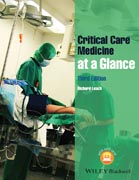
INDICE: Dedication Preface Acknowledgements Units, symbols and abbreviations Part 1 General 1. Recognising the acutely unwell patient 2. Managing of the critically ill patient 3. Monitoring in critical care medicine 4. The electrocardiogram 5. Cardiopulmonary resuscitation 6. Oxygen transport 7. Shock 8. Circulatory assessment 9. Fluid management: pathophysiological factors 10. Fluid management: assessment and prescription 11. Fluid management: fluid choice 12. Inotropes and vasopressors 13. Failure of oxygenation and respiratory failure 14. Oxygenation and oxygen therapy 15. Airways obstruction and management 16. Non–invasive ventilation 17. Endotracheal intubation 18. Mechanical ventilation 19. Respiratory management, weaning and tracheostomy 20. Arterial blood gases and acid–base balance 21. Analgesia, sedation and paralysis 22. Enteral and parenteral nutrition 23. Hypothermia and hyperthermia 24. Assessment of the patient with suspected infection 25. Bacteraemia, SIRS and sepsis 26. Hospital–acquired (nosocomial) infections 27. Fever in the returning traveller 28. Fever (pyrexia) of unknown origin 29. End of life issues Part 2 Medical Cardiac 30. Acute coronary syndromes I: clinical pathophysiology 31. Acute coronary syndromes II: investigations and management 32. Arrhythmia: tachyarrhythmia 33. Arrhythmia: bradyarrhythmia 34. Heart failure and pulmonary oedema 35. Cardiac emergencies 36. Deep venous thrombosis and pulmonary embolism Respiratory 37. Chest imaging and bronchoscopy 38. Community–acquired pneumonia 39. Hospital–acquired (nosocomial) pneumonia 40. Asthma 41. Chronic obstructive pulmonary disease 42. Acute respiratory distress syndrome 43. Pneumothorax and air leaks 44. Respiratory emergencies Renal and metabolic 45. Acute kidney injury: pathophysiology and clinical aspects 46. Acute kidney injury: management and renal replacement therapy 47. Electrolyte disturbance: sodium and potassium 48. Electrolyte disturbance: calcium 49. Electrolyte disturbance: magnesium and phosphate 50. Diabetic emergencies 51. Endocrine emergencies Gastrointestinal 52. Gastrointestinal haemorrhage 53. Jaundice 54. Acute liver failure 55. Acute pancreatitis 56. Vomiting and intestinal obstruction 57. Diarrhoea 58. Ascites 59. Abdominal imaging Neurological 60. Acute confusional state, coma and status epilepticus 61. Stroke 62. Other cerebral vascular disorders 63. Infective neurological emergencies 64. Neuromuscular conditions Infective 65. Specific bacterial infections 66. Common adult viral infections 67. Common fungal and protozoal infections 68. The immune compromised patient Other systems 69. Coagulation disorders and transfusion 70. Drug overdose and poisoning Part 3 Surgical 71. Trauma 72. Head injury 73. Chest trauma 74. Acute abdominal emergencies 75. Obstetric emergencies 76. Burns, toxic inhalation and electrical injuries Part 4 Self assessment Case studies and questions Case studies answers Appendices Appendix I: Classification of antiarrhythmic drugs Appendix II: Acute injury network staging system 2008 for acute kidney injury Appendix III: Rockall risk–scoring system for GI bleeds Appendix IV: Child–Pugh grading Appendix V: Typical criteria for liver transplantation Appendix VI: RCP ten top nutrition tips Index
- ISBN: 978-1-118-30276-7
- Editorial: Wiley–Blackwell
- Encuadernacion: Rústica
- Páginas: 192
- Fecha Publicación: 04/07/2014
- Nº Volúmenes: 1
- Idioma: Inglés
